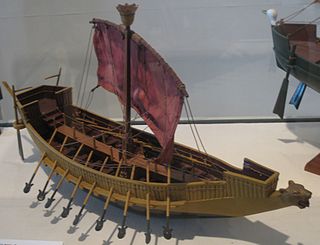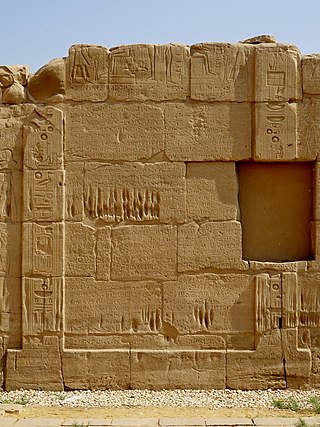
The Hittites were an Anatolian Indo-European people who formed one of the first major civilizations of Bronze Age West Asia. Possibly originating from beyond the Black Sea, they settled in modern day Turkey in the early 2nd millennium BC. The Hittites formed a series of polities in north-central Anatolia, including the kingdom of Kussara, the Kanesh or Nesha kingdom, and an empire centered on Hattusa. Known in modern times as the Hittite Empire, it reached its height during the mid-14th century BC under Šuppiluliuma I, when it encompassed most of Anatolia and parts of the northern Levant and Upper Mesopotamia.

The Philistines were an ancient people who lived on the south coast of Canaan during the Iron Age. The Philistines originated as an immigrant group from the Aegean that settled in Canaan circa 1175 BC, during the Late Bronze Age collapse. Over time, they gradually assimilated elements of the indigenous Semitic Levantine societies while preserving their own unique culture. In 604 BC, the Philistine polity, after having already been subjugated for centuries by the Neo-Assyrian Empire, was finally destroyed by King Nebuchadnezzar II of the Neo-Babylonian Empire. After becoming part of his empire and its successor, the Persian Empire, the Philistines lost their distinct ethnic identity and disappeared as a people from the historical and archaeological record by the late 5th century BC.

Philistia was a confederation of five main cities or pentapolis in the Southwest Levant, made up of principally Gaza, Ashkelon, Ashdod, Ekron, and Gath, and for a time, Jaffa.

Usermaatre Meryamun Ramesses III was the second Pharaoh of the Twentieth Dynasty in Ancient Egypt. He is thought to have reigned from 26 March 1186 to 15 April 1155 BC and is considered to be the last great monarch of the New Kingdom to wield any substantial authority over Egypt.

The Sea Peoples are a hypothesized seafaring confederation that attacked ancient Egypt and other regions in the East Mediterranean before and during the Late Bronze Age collapse. Following the creation of the concept in the 19th century, the Sea Peoples' incursions became one of the most famous chapters of Egyptian history, given its connection with, in the words of Wilhelm Max Müller, "the most important questions of ethnography and the primitive history of classic nations".

Kadesh, or Qadesh, was an ancient city of the Levant on or near the headwaters or a ford of the Orontes River. It was of some importance during the Late Bronze Age and is mentioned in the Amarna letters. It was the site of the Battle of Kadesh between the Hittite and Egyptian empires in the 13th century BC.

The Battle of Kadesh took place between the Egyptian Empire and the Hittite Empire in the 13th century BC, with the former led by Ramesses II and the latter led by Muwatalli II. Both sides engaged each other at the Orontes River, just upstream of Lake Homs and near the archaeological site of Kadesh, along what is today the Lebanon–Syria border.

The New Kingdom, also referred to as the Egyptian Empire, was the ancient Egyptian nation between the 16th century BC and the 11th century BC. This period of ancient Egyptian history covers the Eighteenth, Nineteenth, and Twentieth Dynasties. Through radiocarbon dating, the establishment of the New Kingdom has been placed between 1570 BC and 1544 BC. The New Kingdom followed the Second Intermediate Period and was succeeded by the Third Intermediate Period. It was the most prosperous time for the Egyptian people and marked the peak of Egypt's power.

Carchemish, also spelled Karkemish, was an important ancient capital in the northern part of the region of Syria. At times during its history the city was independent, but it was also part of the Mitanni, Hittite and Neo-Assyrian Empires. Today it is on the frontier between Turkey and Syria.

Papyrus Harris I is also known as the Great Harris Papyrus and simply the Harris Papyrus. Its technical designation is Papyrus British Museum EA 9999. At 41 metres long, it is "the longest known papyrus from Egypt, with some 1,500 lines of text." It was found in a tomb near Medinet Habu, across the Nile river from Luxor, Egypt, and purchased by collector Anthony Charles Harris (1790–1869) in 1855; it entered the collection of the British Museum in 1872.

The Peleset or Pulasati were one of the several ethnic groups the Sea Peoples were said to be composed of, appearing in fragmentary historical and iconographic records in ancient Egyptian from the Eastern Mediterranean in the late 2nd millennium BCE.

The Temple of Ramesses III at Medinet Habu was an important New Kingdom period temple structure in the West Bank of Luxor in Egypt. Aside from its size and architectural and artistic importance, the mortuary temple is probably best known as the source of inscribed reliefs depicting the advent and defeat of the Sea Peoples during the reign of Ramesses III.

The Late Bronze Age collapse was a time of widespread societal collapse during the 12th century BC, between c. 1200 and 1150, and was associated with environmental change, mass migration and destruction of cities. The collapse affected a large area of the Eastern Mediterranean and the Near East, in particular Egypt, eastern Libya, the Balkans, the Aegean, Anatolia, and the Caucasus. It was sudden, violent, and culturally disruptive for many Bronze Age civilizations, and it brought a sharp economic decline to regional powers, notably ushering in the Greek Dark Ages.
The Amqu is a region during the Late Bronze Age, equivalent to the Beqaa Valley region in eastern Lebanon, named in the 1350–1335 BC Amarna letters corpus.

The Battle of Djahy was a major land battle between the forces of Pharaoh Ramesses III and the Sea Peoples who intended to invade and conquer Egypt. The conflict occurred on the Egyptian Empire's easternmost frontier in Djahy, or modern-day southern Lebanon, in the eighth year of Ramesses III or about c. 1178 BC.

Ramesses II, commonly known as Ramesses the Great, was an Egyptian pharaoh. He was the third ruler of the Nineteenth Dynasty. Along with Thutmose III of the Eighteenth Dynasty, he is often regarded as the greatest, most celebrated, and most powerful pharaoh of the New Kingdom, which itself was the most powerful period of ancient Egypt. He is also widely considered one of ancient Egypt's most successful warrior pharaohs, conducting no fewer than 15 military campaigns, all resulting in victories, excluding the Battle of Kadesh, generally considered a stalemate.

The ancient Egyptian navy has a very extensive history almost as old as the nation itself. The best sources over the type of ships they used and their purposes come from the reliefs from the various religious temples that spread throughout the land. While the early ships that were used to sail the Nile were often made out of reeds, the ocean and seagoing ships were then made out of cedar wood, most probably from the woods of Byblos in present day Lebanon. While the use of navy was not as important to the Egyptians as it may have been to the Greeks or Romans, it still proved its worth during the Thutmoside campaigns and even in defending Egypt under Rameses III. Thutmose III understood the importance in maintaining a fast and efficient communications and supply line that would connect his bases in the Levantine region with Egypt. For this reason, he constructed his famous dockyard for the royal fleet near Memphis, whose sole purpose was to constantly supply the campaigning Egyptian army with additional troops as well as communication with Egypt and general supplies.

The Nineteenth Dynasty of Egypt, also known as the Ramessid dynasty, is classified as the second Dynasty of the Ancient Egyptian New Kingdom period, lasting from 1292 BC to 1189 BC. The 19th Dynasty and the 20th Dynasty furthermore together constitute an era known as the Ramesside period. This Dynasty was founded by Vizier Ramesses I, whom Pharaoh Horemheb chose as his successor to the throne.

The Twentieth Dynasty of Egypt is the third and last dynasty of the Ancient Egyptian New Kingdom period, lasting from 1189 BC to 1077 BC. The 19th and 20th Dynasties furthermore together constitute an era known as the Ramesside period. This dynasty is generally considered to be the start of the decline of Ancient Egypt.

The Egyptian–Hittite peace treaty, also known as the Eternal Treaty or the Silver Treaty, is the only Ancient Near Eastern treaty for which the versions of both sides have survived. It is also the earliest known surviving peace treaty. It is sometimes called the Treaty of Kadesh, after the well-documented Battle of Kadesh that had been fought some 16 years earlier, although Kadesh is not mentioned in the text. The treaty was concluded between Egyptian pharaoh Ramesses II and king of the Hittite empire Ḫattušili III in c. 1259 BC. Both sides of the treaty have been the subject of intensive scholarly study. The treaty itself did not bring about a peace; in fact, "an atmosphere of enmity between Hatti and Egypt lasted many years" until the eventual treaty of alliance was signed.



















